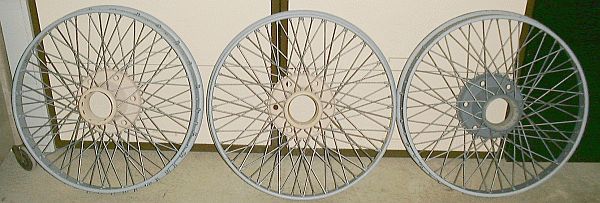|
The wheel on the right (the first wheel done) has 66 spokes arranged in three patterns of 22 spokes. Eleven spokes of the group are routed clockwise with respect to the hub and the remaining eleven spokes of the group are routed counter-clockwise with respect to the hub such that a pair of spokes crosses a short distance from the hub to form a small, nearly equilateral triangle. Each grouping of 22 spokes in a pattern effectively forms a layer of spokes. The inside layer of spokes or layer closest to the axle goes between the inside of the hub and the inside of the rim. These are the only spokes that go to a row of holes at the inside of the rim. The next layer is routed between the inside of the hub and the outside of the rim. Basically this group of spokes provides diagonal support to the rim as they are routed from the rear of the hub to the outside of the rim. The last grouping of spokes is routed from the outside of the hub to the outside of the rim. These spokes are also laced at an angle to provide diagonal support to the rim and are laced between the second spoke group that routes to the rear of the hub. If you've counted spokes by now you've learned that the middle and left wheels both have 72 spokes or three groupings of 24 spokes (12 spokes are laced clockwise and the remaining 12 of the group are laced counter-clockwise). That is the first difference in the wheels. One wheel is spoked with 66 spokes while the remaining four are spoked with 72 spokes. Now, there is yet another difference. Can you spot this remaining difference? Look at the way the spokes are laced with respect to their clockwise and counter-clockwise routing. You'll see the spokes leaving the hub form a little triangle. If you look carefully between the left and middle wheels you'll see the spoke pattern is flipped in forming the triangle. If you look at the middle and right wheel you'll observe that the triangles are made the same. I'll identify these two spoke patterns as "A" and "B". So, in summary, the spoke patterns are; How the car ever ended up with this combination of wheels is unknown. Obviously the three wheels that are the same were probably supplied by Stanley with the car when it was new. What is fun is to point out to people that there is a difference and to then observe them really studying the wheels as they are placed on the car to see what the differences might be. |
